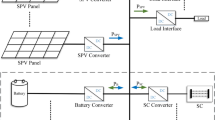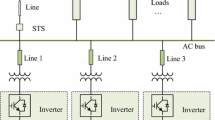Abstract
Inverter is required to operate at both grid-connected and grid-forming mode for microgrid. When an unplanned microgrid disconnecting to grid circumstance happens, the transition will cause severe current shock to system with multi-parallel microgrid inverters. This paper adopts a dynamic virtual resistance-based droop control strategy and small signal analysis method to reduce the current shock, improve the system stability and safety. The large dynamic virtual resistance is added to the control loop when the mode transition event occurs so the shock current is limited. Comparison between the capacitor current feedback for seamless mode transition method and the proposed method is made to prove the validation, and parameters’ impact on the system is also analyzed. Results, which are conducted on MATLAB/Simulation and Hardware-in-the-Loop (HIL) experimental platform verify the feasibility of the proposed method in this paper, effectively reduce the current shock by more than 60%.












Similar content being viewed by others
Data availability
Data tables from this paper are available.
References
Li J, Xue Y, Tian L et al (2017) Research on optimal configuration strategy of energy storage capacity in grid-connected microgrid. Prot Control Modern Power Syst 2(35):35–42
Sharma G, Narayanan K, Adefarati T et al (2022) Frequency regularization of a linked wind–diesel system using dual structure fuzzy with ultra-capacitor. Prot Control Modern Power Syst 7(12):1–9
Tiwari R, Singh RK, Choudhary NK (2022) Coordination of dual setting overcurrent relays in microgrid with optimally determined relay characteristics for dual operating modes. Prot Control Modern Power Syst 7(6):1–18
Cao W, Ma Y, Wang F (2017) Sequence-impedance-based harmonic stability analysis and controller parameter design of three-phase inverter-based multibus AC power systems. IEEE Trans Power Electron 32(10):7674–7693
Wang X, Blaabjerg F, Wu W (2014) Modeling and analysis of harmonic stability in an AC power-electronics-based power system. IEEE Trans Power Electron 29(12):6421–6432
Andishgar MH, Gholipour E et al (2017) An overview of control approaches of inverter-based microgrids in islanding mode of operation. Renew Sustain Energy Rev 80:1043–1060
Cao W, Zhang X, Ma X et al. (2016) Stability criterion and controller parameter design of radial-line renewable systems with multiple inverters. 2016 IEEE applied power electronics conference and exposition (APEC), Long Beach, CA, 2229–2236
Vukojevic A, Lukic S (2020) Microgrid protection and control schemes for seamless transition to island and grid synchronization. IEEE Trans Smart Grid 11(4):2845–2855
Ganjian-Aboukheili M, Shahabi M, Shafiee Q et al (2020) Seamless transition of microgrids operation from grid-connected to islanded mode. IEEE Trans Smart Grid 11(3):2106–2114
Arafat MN, Elrayyah A and Sozer Y (2014) An effective smooth transition control strategy using droop-based synchronization for parallel inverters. 2014 IEEE energy conversion congress and exposition (ECCE), Pittsburgh, PA, 2014: 3964–3970
Lo K, Chen Y (2020) Design of a seamless grid-connected inverter for microgrid applications. IEEE Trans Smart Grid 11(1):194–202
Babqi J, Etemadi AH (2017) MPC-based microgrid control with supplementary fault current limitation and smooth transition mechanisms. IET Gener Transm Distrib 11(9):2164–2172
Lou G, Gu W, Wang J, Wang J, Gu B (2018) A unified control scheme based on a disturbance observer for seamless transition operation of inverter-interfaced distributed generation. IEEE Trans Smart Grid 9(5):5444–5454
Ibrahim MYA, Hatem Z, Salama MMA (2012) Formation and robust control of distributed generation microgrids via direct voltage control and optimized dynamic power sharing. IEEE Trans Power Electron 27(3):1283–1294
Talapur GG, Suryawanshi HM, Xu L, Shitole AB (2018) A reliable microgrid with seamless transition between grid connected and islanded mode for residential community with enhanced power quality. IEEE Trans Ind Appl 54(5):5246–5255
Ochs DS, Mirafzal B, Sotoodeh P (2014) A method of seamless transitions between grid-tied and stand-alone modes of operation for utility-interactive three-phase inverters. IEEE Trans Ind Appl 50(3):1934–1941
Buduma P, Das MK, Naayagi RT et al (2022) Seamless operation of master-slave organized AC microgrid with robust control, islanding detection, and grid synchronization. IEEE Trans Ind Appl 58(5):6724–6738
Nguyen TH, Van TL, Nawaz A et al (2021) Feedback linearization-based control strategy for interlinking inverters of hybrid AC/DC microgrids with seamless operation mode transition. Energies 14:5613
Benadli R, Khiari B and Sellami A (2015) Three-phase grid-connected photovoltaic system with maximum power point tracking technique based on voltage-oriented control and using sliding mode controller. IREC2015—The sixth international renewable energy congress, Sousse, pp. 1–6.
Tran T, Chun T, Lee H, Kim H, Nho E (2013) PLL-based seamless transfer control between grid-connected and islanding modes in grid-connected inverters. IEEE Trans Power Electron 29(10):5218–5228
Kadri R, Gaubert J, Champenois G (2011) An improved maximum power point tracking for photovoltaic grid-connected inverter based on voltage-oriented control. IEEE Trans Industr Electron 58(1):66–75
Hornik T, Zhong QC (2010) H∞ repetitive voltage control of grid-connected inverters with a frequency dynamic mechanism. IET Power Electron 3(6):925–935
Lei Q, Yang S and Peng FZ (2010) Multi-loop control algorithms for seamless transition of grid-connected inverter [C]. 2010 Twenty-fifth annual IEEE applied power electronics conference and exposition (APEC), Palm Springs, CA, pp. 844–848
Srinivas VL, Singh B, Mishra S (2020) seamless mode transition technique for virtual synchronous generators and method thereof. IEEE Trans Industr Inf 16(8):5254–5266
Li X, Zhang H, Shadmand MB, Balog RS (2017) Model predictive control of a voltage-source inverter with seamless transition between islanded and grid-connected operations. IEEE Trans Industr Electron 64(10):7906–7918
Ramezani M, Li S, Musavi F, Golestan S (2020) Seamless transition of synchronous inverters using synchronizing virtual torque and flux linkage. IEEE Trans Industr Electron 67(1):319–328
Souza M, Freitas L (2022) Grid-connected and seamless transition modes for microgrids: an overview of control methods, operation elements, and general requirements. IEEE Access 10:97802–97834
Huang L, Xin H, Dörfler F (2020) H∞-control of grid-connected converters: design, objectives and decentralized stability certificates. IEEE Trans Smart Grid 11(5):3805–3816
Dong J, Gong C, Chen H et al (2021) Secondary frequency regulation and stabilization method of islanded droop inverters based on integral leading compensator. Energy Rep 8:1718–1730
Acknowledgements
The authors would like to acknowledge the following agency for the support: Supported by National Key Research and Development Project (Grant No. 2018YFB1503000, 2018YFB1503001) and Shanghai Science and Technology Commission Program (Grant No. 21DZ1207300).
Funding
Funding supporting this paper are from public R&D fund of China rather than personal support.
Author information
Authors and Affiliations
Contributions
Dr. J.D. are responsible for the writing, and experiment design of the paper. Mr.C.G, J.B. and L.Z. are responsible for the project support of the paper. Professor Z.W. is responsible for the supervision of the whole project, research and lab.
Corresponding author
Ethics declarations
Competing interests
The authors declare no competing interests.
Ethical approval
The paper is ethical approval and has no relationship with human and animal studies.
Additional information
Publisher's Note
Springer Nature remains neutral with regard to jurisdictional claims in published maps and institutional affiliations.
Appendices
Appendix A Abbreviation and variable list
PLL | Phase lock loop |
HIL | Hard ware in the loop |
PCC | Point of common coupling |
I cc | Circling current among inverters |
R v | Dynamic virtual resistance |
R s | Initial value of virtual resistance |
R 0 | Eventual value of virtual resistance |
τ | Time constant of proposed method |
t 0 | Initial time for mode transition |
u * c,dq | Input reference of inner voltage and current loop |
ũ * c,dq | Output voltage reference from droop loop |
i 2,dq | Output current of the inverter |
L v | Virtual inductance |
Guref(s) | Transfer function from voltage reference to output voltage in voltage-oriented scheme |
Zo(s) | Output impedance in voltage-oriented scheme |
Yo(s) | Output conduction in current-oriented scheme |
Giref(s) | Transfer function from current reference to output current in current-oriented scheme |
L 1 | Machine side inductor in LCL filter |
L 2 | Grid side inductor in LCL filter |
C 1 | Capacitor in LCL filter |
i 1,dq | Current on L1 |
i 2,dq | Current on L2 |
u c,dq | Voltage on C1 |
u s,dq | Output voltage behind the IGBT bridge |
u pcc,dq | Voltage on PCC |
x filt | State space variable for the LCL filter |
A f , B f1 , B f2 | Parameter matrices for state space model of LCL filter |
k pin | Proportional gain for the current loop from inner loop |
k po | Proportional gain for the voltage loop from inner loop |
k io | Integral gain for the voltage loop from inner loop |
i * 1,dq | Current reference for current loop from inner loop |
x s | State space variable for inner loop controller |
As, Bs1, Bs2, Cs, Ds1, Ds2 | Parameter matrices for inner loop controller |
T hpf | Time constant of high pass filter in virtual impedance method |
x v | State space variable for virtual impedance loop |
Av, Bv1, Bv2, Cv, Dv1, Dv2 | Parameter matrices for virtual impedance loop |
n Q | Reactive power droop coefficient |
n P | Active power droop coefficient |
Q o | Reactive power output |
P o | Active power output |
T lfp | Time constant of low pass filter from droop loop |
x dq | State space variable for droop loop |
A pq , B pq , C pq | Parameter matrices for droop loop |
[Ps, Qs] | Power reference array for grid-connected mode |
Appendix B Transfer function in Sect. 3
For voltage-oriented mode controller
where,
And Ts is the control period time of inner PWM. For current-oriented mode controller
where,
Appendix C Parameter description in Sect. 4.1
Define the following matrix for simple.
From Eq. (7)
From Eq. (8)
From Eq. (9)
From Eq. (10)
Ainv is gotten by state space expansion for the sake of simplicity.
Rights and permissions
Springer Nature or its licensor (e.g. a society or other partner) holds exclusive rights to this article under a publishing agreement with the author(s) or other rightsholder(s); author self-archiving of the accepted manuscript version of this article is solely governed by the terms of such publishing agreement and applicable law.
About this article
Cite this article
Dong, J., Gong, C., Bao, J. et al. Dynamic virtual resistance-based droop control for seamless transition operation of multi-parallel microgrid inverters. Electr Eng 105, 1163–1177 (2023). https://doi.org/10.1007/s00202-022-01723-0
Received:
Accepted:
Published:
Issue Date:
DOI: https://doi.org/10.1007/s00202-022-01723-0




